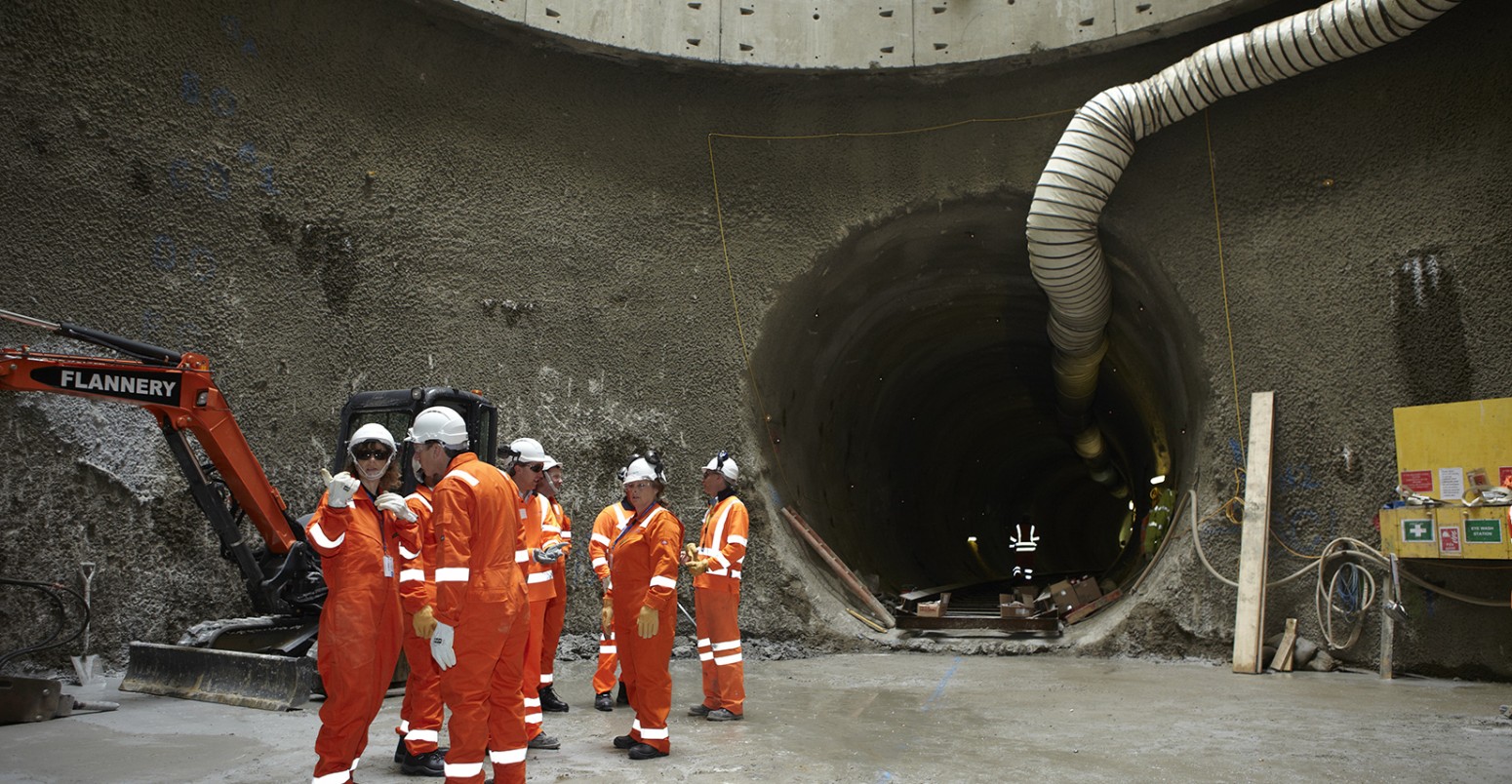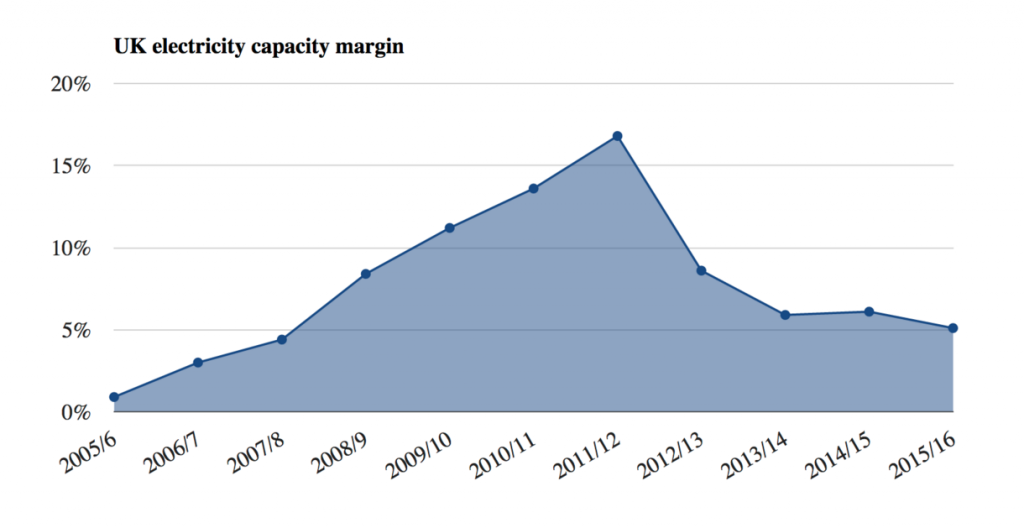
Q & A: National Grid’s winter outlook for electricity supplies
Simon Evans
10.15.15The UK has enough electricity generating capacity to cover demand throughout the cold winter months, according to National Grid.
Its annual Winter Outlook report, published this week, says there will be a 5.1% buffer between peak electricity demand and the capacity available to meet it.
Cordi O’Hara director of National Grid, says margins will be “tight, but manageable”. Yet some newspapers trailed the report over the weekend with headlines about blackouts.
Carbon Brief runs through the story of the report and how it has been covered.
Will the lights go out?
In short, it’s very unlikely. The National Grid says it has the tools it needs to keep the lights on and ministers’ reputations are staked on the “non-negotiable” imperative of securing electricity supplies.
National Grid has eight separate reserves, including the Short-Term Operating Reserve (STOR), Fast Start reserve and Scheduled Reserve. In 2014 it added the Supplemental Balancing Reserve (SBR) and Demand Side Balancing Reserve (DBSR), discussed in more detail below.
These reserves are part of a range of options the grid can use to balance supply and demand. As Carbon Brief explained last year, the grid is conservative in its approach to contingency planning. It also applies conservative assumptions to its winter outlook forecasts, such as assuming demand will remain constant at around 54 gigawatts (GW) even though it’s been falling for a decade.
This winter’s 5.1% capacity margin is lower than last year’s 6.1%, but above the levels seen a decade ago when the lights conspicuously failed to go out (chart, below).

The buffer between forecast peak electricity demand each winter and the generating capacity available to meet demand. Figures for this winter and last include National Grid’s SBR and DSBR services. Source: National Grid. Chart by Carbon Brief.
Why are margins tight?
The shape of the UK’s generating capacity is changing as thousands of renewable sites are added to an ageing fleet of tens of large centralised coal, nuclear and gas plants. The UK has added 16GW of renewables since 2010 and 4GW of gas, though the gas was all added before 2012.
While overall capacity has grown, windfarms do not always produce power and all power stations sometimes break down. After accounting for the average expected availability of different types of generation, National Grid says capacity is shrinking. This means shrinking margins, even though demand is falling, too.
It’s common for newspaper articles to blame tight margins on the drive to decarbonise the UK’s electricity sector. The truth is more complex, however. Old coal and nuclear plants are closing due to age and tightening air pollution rules. Existing gas plants have been struggling financially across Europe, with the economics for new gas looking even less favourable.
Margins are expected to tighten further next spring if three large coal plants follow through with plans to close down. It’s also rumoured that the government will move to phase out coal completely at some point in the 2020s.
What is being done?
To cope with shrinking margins, National Grid introduced its SBR and DSBR schemes in 2014. The first of these pays for power stations to be held in reserve, ready to switch on if the open market is unable to meet demand. This covers several large plants totalling 2.29GW.
The smaller 0.13GW DSBR scheme contracts with large energy users, paying them to reduce their usage during peak demand. Firms already opt to do this to a certain extent in what’s called “triad avoidance“, where they try to reduce usage during the year’s three demand peaks, or triads. The timing of triads is unpredictable, but they tend to be weekday evenings in December or January.
Demand response of this sort is sometimes caricatured as factories being forced to switch off on winter evenings. A new report for government lists the many options for businesses choosing to participate in the scheme, such as shifting demand for water heating or industrial cooling.
Demand response typically meets up to 10% of peak demand in some US power markets, and it is widespread in Germany. Similar rates of demand response are probably available in the UK.
What about government?
For the longer term, the government has set up a capacity market, designed to secure enough supplies to meet demand well in advance. The first capacity auctions, for delivery in 2018, have been heavily oversubscribed suggesting there will be more than enough generation available.
However, there are concerns around the scheme’s ability to secure new gas capacity. The Department for Energy and Climate Change (DECC) hopes to tweak the scheme so as to secure more new gas in future auctions, according to a new consultation.
The changes could also help to encourage demand side participation in future auctions. They appear to respond to concerns about its design, raised in an independent review.
The rules governing the balancing market, where companies trade to settle differences between expected supplies and the amount of electricity they actually deliver, are also being changed in ways designed to help encourage security of supply.
Ben Irons, a director at Aurora Energy Research, says in a statement:
From 2018 the government’s capacity mechanism will come into effect and is already oversubscribed. The mixture of gas, demand response, interconnection and storage this will bring forward, mean capacity shortages won’t be an issue.
Even if all the UK’s coal plants are closed down there is enough time to replace them with new gas plants, Irons says. DECC has recently approved construction of several new gas-fired power stations, though they are unlikely to proceed unless they receive capacity market contracts.
Meanwhile, the capacity of interconnector cables linking the UK’s grid to others’ is set to double, with new schemes to France, the Netherlands, Norway and Belgium in the pipeline.
The combination of plans put in place by National Grid and the government is enough to reassure Jon Ferris, head of energy markets at consultancy Utilitywise. In an article published over the summer, he said he’s “betting against a winter of blackouts”.
Didn’t newspapers say blackouts loom?
Yes. Over recent weeks, newspaper headlines have issued a series of warnings. These include: “Blackout risk rises” (the Telegraph), “Pricey winter blackouts loom” (Daily Mirror), “Winter blackout fear” (Mail on Sunday), “Britain facing winter BLACKOUTS” (Express) and, “Britain may have to ‘go Dutch’ to avoid blackouts” (the Times).
The articles generally fail to distinguish between short term challenges over the next three winters, when National Grid will have to manage demand using its existing reserve schemes, and the longer term shift to a capacity market, which will, theoretically, banish blackout fears for good.
Amber Rudd, energy and climate change secretary, wrote to the Times to rebuff claims of blackout risk. Last year, it was former secretary of state Ed Davey who had this unenviable task. As Carbon Brief has noted previously, there are newspaper headlines warning of blackouts every single year.
Despite the headlines, in recent years we “haven’t even come close” to blackouts, says Michael Grubb, professor of international energy and climate change policy at Imperial College.
There have been more than 500 articles over the past ten years warning of blackouts. The period has seen just one outage related to inadequate generation capacity, after two conventional power stations broke down at the same time.
Grubb tells Carbon Brief:
I’m not sure there’s any other area of policy with quite such a large gap between perception and reality.
One obvious question is why this reality gap persists. There are a number of plausible reasons, such as the fact that blackouts and lights going out make for more compelling headlines. Another possibility is that a heightened fear of blackouts is in certain actors’ interests.
Many of the articles on blackouts suggest they can only be avoided if new nuclear, coal or even shale gas schemes are allowed to go ahead.
Grubb says: “It’s obviously in industry interests to have as many headlines as possible.” It’s possible, for instance, that coal plants announcing the intention to close next spring might be persuaded to stay open — or at least remain on standby — if they receive government support.
Doug Parr, chief scientist for Greenpeace, says:
Every year the national grid say they can keep the lights on, but every winter some still say our energy infrastructure will struggle to cope with a cold snap, alongside energy firms knocking on the government’s door for more handouts.

